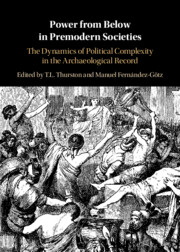 Power from Below in Premodern Societies
Power from Below in Premodern Societies Published online by Cambridge University Press: 08 October 2021
Rural sociopolitical complexity in premodern states was quite extensive but variable. However, archaeologists and cultural anthropologists have been slow to recognize and study institutional complexity in rural contexts. Much ink has been spilled regarding economic relationships, “centralized” control, and “imagined communities” (e.g., Davis-Salazar, 2003; Earle & Spriggs, 2015; Flannery, 1972; Isbell, 2000; Kirch, 2010; Paris, 2014; Sanders & Price, 1968; Wright, 1977; Yaeger & Canuto, 2000). But the development of infrastructural power, especially collective power, in rural settlements and its relationship with regional or macroregional political structures has received only scant attention. With respect to contemporary cases, which provide important theoretical frameworks, anthropologists have taken a back seat to political scientists (e.g., Ostrom, 2015; see Lansing, 2012 for an important [partial] exception), whose focus has been on the management of common pool resources – a topic generally ignored by archaeologists. Unfortunately, neither political scientists nor anthropologists have invested much in understanding cooperation and public goods provisioning in rural settlements and landscapes. Conversely, we have made some initial forays into the issue of rural institutional complexity in premodern states and civilization (Blanton & Fargher, 2008); and here we expand to some degree on that discussion.
To save this book to your Kindle, first ensure [email protected] is added to your Approved Personal Document E-mail List under your Personal Document Settings on the Manage Your Content and Devices page of your Amazon account. Then enter the ‘name’ part of your Kindle email address below. Find out more about saving to your Kindle.
Note you can select to save to either the @free.kindle.com or @kindle.com variations. ‘@free.kindle.com’ emails are free but can only be saved to your device when it is connected to wi-fi. ‘@kindle.com’ emails can be delivered even when you are not connected to wi-fi, but note that service fees apply.
Find out more about the Kindle Personal Document Service.
To save content items to your account, please confirm that you agree to abide by our usage policies. If this is the first time you use this feature, you will be asked to authorise Cambridge Core to connect with your account. Find out more about saving content to Dropbox.
To save content items to your account, please confirm that you agree to abide by our usage policies. If this is the first time you use this feature, you will be asked to authorise Cambridge Core to connect with your account. Find out more about saving content to Google Drive.